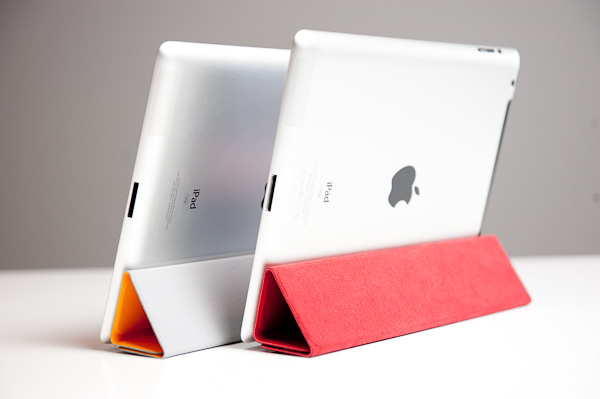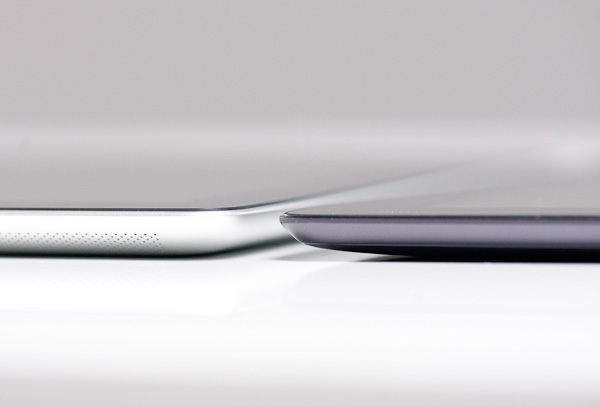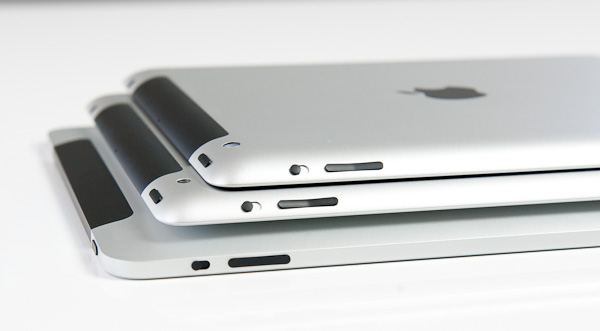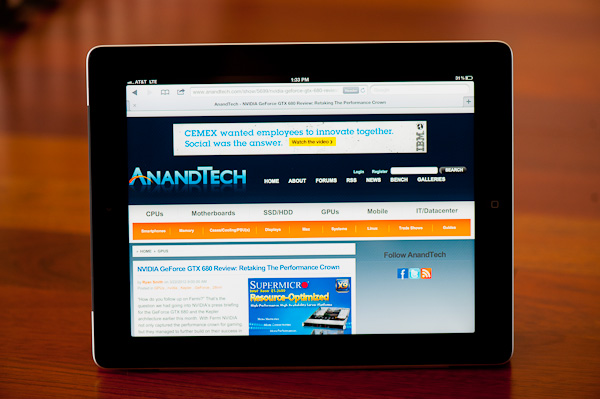The Apple iPad Review (2012)
by Vivek Gowri & Anand Lal Shimpi on March 28, 2012 3:14 PM ESTThe new iPad
First things first, the name. It's the new iPad, or simply the iPad, not the iPad 3, iPad 2S, iPad HD or any other variation on the theme—no more alphanumerics after the product name. Like the car industry, Apple has started peddling its wares by model years. It's a marketing coup for Apple, and their ability to pull it off in the computer industry shows how far they've come in the last five years.
Like the iPhone 4S, the iPad update mostly focuses on a component level, with only minor external changes being made to the hardware. Obviously, the Retina Display is the headline feature here, being the basis of Apple’s marketing campaign for the new iPad. It brings a resolution of 2048x1536 to the iPad’s 9.7” display, boosting pixel density to an impressive 264 dots per square inch. This isn’t quite as concentrated as the iPhone 4/4S Retina Display, which has a density of 326dpi, but because the viewing distance for a tablet is expected to be greater than a phone, effective pixel density is similar. The highest pixel density we’ve seen in a tablet prior to this is 224, with a brace of Android tablets from ASUS, Acer, Huawei, amongst others, boasting 10.1” WUXGA panels.
To keep up with the QXGA display, Apple chose to update their A5 SoC to suit the needs of the new device. Called the A5X, the new chip retains the pair of 1GHz ARM Cortex A9 cores from the A5 but features a quad-core replacement for the already potent dual-core PowerVR SGX 543MP2 graphics processor. With the quad-core version, known as the SGX 543MP4, Apple claims that graphics performance has doubled with respect to the SGX 543MP2. Given that SGX 543MP4 is basically the same as SGX 543MP2 except with twice as many execution cores, the claim indicates that Apple kept the GPU clock at 250MHz. SGX 543MP2 was overkill for the iPad 2’s XGA display, but the iPad’s QXGA screen is so vast in terms of pixel count that the more powerful GPU was likely necessary just to drive the display smoothly. In addition to the SoC update, the new iPad got a much-needed bump to 1GB of system RAM.
The increase in number of pixels (and transistors powering the display—one for each RGB subpixel) comes with a corresponding increase in the percentage of light being blocked by the transistors and filaments. Thus, the percentage transparent area for each pixel is lower, necessitating a significantly stronger backlight when pixel density is increased. Between the more power-hungry backlight and the faster SoC, the power consumption of the iPad is significantly greater than it was previously. And so, the 25Wh battery was swapped out for a downright huge 42.5Wh Lithium-polymer pack. That’s well into ultrabook territory as far as battery capacity goes—it’s bigger, actually, than the 35Wh battery in the 11” Macbook Air. Apple claims 10 hours of battery life, identical to the previous WiFi model, relatively impressive given the increases in power consumption.
After the Retina Display, the most important new addition to the new iPad is the availability of LTE as an option, replacing the 3G models from before. Available in both AT&T and Verizon flavours, the LTE models both make use of Qualcomm’s 45nm MDM9600 LTE baseband. MDM9600 has support for UE Category 3 LTE, CDMA2000 1x/EVDO Rev.A (and B), GSM/EDGE, and WCDMA/HSPA+ all the way through DC-HSPA+ 42 Mbps, so it can roam internationally on 3G as well as connect to 3G in areas without LTE coverage. Unfortunately, the new iPad’s release schedule meant that it missed the 28nm shipping window by a couple of months, so we will probably have to wait until the 2013 iPad to see the more efficient MDM9615 modem.
The third major internal upgrade in the new iPad was the camera: in place of the iPad 2’s 720p rear facing camera raided from the iPod touch-parts bin, the iPad gets the huge upgrade to a 5MP camera with a backlit illuminated sensor and an f/2.4 lens. Basically, it uses the iPhone 4 sensor and iPhone 4S optics, so it’s still a parts-bin special, just with significantly better parts.
As before, the iPad is available with either a black or a white bezel, and pricing and storage options have stayed the same. Each step up in storage size costs $100 (so 32GB costs $100, while 64GB goes $200), and the addition of mobile broadband goes for $130. If you do the math and carry the ones properly, you’ll find MSRPs that range from $499 for the basic 16GB WiFi model all the way up to $829 for the 64GB LTE model. I picked up two 16GB WiFi iPads, a white one for me and a black one for a friend, while Anand picked up a black 16GB unit with Verizon LTE. We rounded out the collection with a black 64GB model on AT&T's LTE network.
| Tablet Specification Comparison | |||||||
| ASUS Transformer Pad Infinity | Apple's new iPad (2012) | Apple iPad 2 | Apple iPad | ||||
| Dimensions | 263 x 180.8 x 8.5mm | 241.2 x 185.7 x 9.4mm | 241.2 x 185.7 x 8.8mm | 243.0 x 190.0 x 13.4mm | |||
| Display | 10.1-inch 1920 x 1200 Super IPS+ | 9.7-inch 2048 x 1536 IPS | 9.7-inch 1024 x 768 IPS | 9.7-inch 1024 x 768 IPS | |||
| Weight | 586g | 652g (WiFi) | 601g (WiFi) | 680g (WiFi) | |||
| Processor |
3G/4G LTE—1.5GHz Qualcomm Snapdragon S4 MSM8960 (2 x Krait) WiFi—1.6GHz NVIDIA Tegra 3 T33 (4 x Cortex A9) |
Apple A5X (2 x Cortex A9, PowerVR SGX 543MP4) |
1GHz Apple A5 (2 x Cortex A9, PowerVR SGX543MP2) | 1GHz Apple A4 (1 x Cortex A8, PowerVR SGX 535) | |||
| Connectivity | WiFi , Optional 4G LTE | WiFi , Optional 4G LTE | WiFi , Optional 3G | WiFi , Optional 3G | |||
| Memory | 1GB | 1GB | 512MB | 256MB | |||
| Storage | 16GB—64GB | 16GB—64GB | 16GB—64GB | 16GB—64GB | |||
| Battery | 25Whr | 42.5Whr | 25Whr | 25Whr | |||
| Pricing | $599—$799 est | $499—$829 | $399, $529 | - | |||
So internally, the iPad is definitely a step or two up from the iPad 2, but what about the device hardware? The short version of the story is that iPad hasn’t changed much at all. And by hasn’t changed much at all, I mean that it looks exactly the same as the iPad 2 except that it’s slightly thicker.
New chassis designs involve a lot of effort—between engineering, development, prototyping, tooling, and manufacturing, the entire process requires a lot of time and money. Apple’s design lifespan directly correlates to the maturity of the product line as well as the competitiveness of the market the product is in. With its mobile device lines, the tendency has been to keep a two year design life for established products. As such, the iPad design stays relatively unchanged, with the same design language as the iPad 2. That device had a ground-up design refresh based on the ergonomically-curved design language that debuted with the fourth-generation iPod touch in September 2010. Overall, we were pretty pleased with the form and aesthetics of the iPad 2, so we’re not sorry to see the design stay much the same.

iPad 2 (left) vs. new iPad (right)
But due to that massive battery, thickness has gone up (by 0.6mm to 9.4mm), and so has weight. At 1.44lbs, the iPad is 0.11lbs heavier than its predecessor (for the WiFi models; the LTE iPad adds 0.12lbs to the outgoing 3G iPad 2’s 1.34lbs). The Retina Display necessitated a faster GPU and a much larger battery to keep performance and battery life similar to the previous level, and you pay for it with a step backwards in terms of form factor. Six-tenths of a millimeter isn’t a lot, but when you consider that the iPad 2 was only 8.8mm thick to begin with, that 0.6mm represents a relatively significant 6.8% increase in thickness. Same goes for the 8.3% weight increase. It’s not a huge deal (after all, we’re talking about fractions of a millimeter and less than 2 ounces of weight), but if you’re familiar with the iPad 2, the additional heft is definitely noticeable.

Left to Right: iPad 2, new iPad, Transformer Prime

The new iPad (left) vs. the ASUS Transformer Prime (right)

iPad 2 (left) vs. new iPad (right)
It’s a little bit of an unfortunate development, because the thinner and lighter form factor was what differentiated the iPad 2 from the original iPad and made it so much more comfortable to hold. The 2012 iPad is now closer to the original iPad in weight, though it’s still significantly thinner—and still nearly as thin as the 9.3mm thick iPhone 4 and 4S, which is worth mentioning while we’re at it. It’s still definitely a thin device, just not as much as before.
And I’m not necessarily convinced that it’s a bad thing. The iPad 2, like the fourth generation iPod touch, was at the low end of skinny for me. At some point, a device becomes so thin that it simply is no longer comfortable to hold, and the iPad 2 and iTouch 4 were close to that line for me. The new iPad just backs away from that line slightly, and on a personal level, I think it’s slightly more comfortable to hold.

From Left to Right: iPad (2010), iPad 2 (2011), iPad (2012)

From Bottom to Top: iPad (2010), iPad 2 (2011), iPad (2012)
However, the weight gain means that the iPad is once again tiring to hold for very long—carrying it with one hand while reading results in more arm fatigue than the iPad 2. The iPad 2 was a significant improvement over the original in this regard particularly, so it’s a a disappointment to see that become an issue once more.
But taken as a whole, the 2012 iPad hardware is a big step forward. It improves on the two major component issues with the iPad 2—the screen and the camera—without making any major concessions with regards to performance, portability or battery life, as we’ll see. The new iPad is just as usable as its predecessor, it's just better.
Anand and I tag teamed this review. I'm responsible for this section, in addition to the intro, iPhoto, camera and Vivek's impressions sections. The rest is told from Anand's perspective. Hopefully that clears up any confusion as you make it through the review.



















234 Comments
View All Comments
mr_ripley - Friday, March 30, 2012 - link
It's a shame some people argue that against the workers when over a hundred of them have committed suicide over the working conditions. How can you still say that they are being offers a better deal here??On the other hand, it is also unfair that Apple is being singled out here. The world of Chinese manufacturing is a dirty one and all major corporations have a part in it. I'd trust Apple over most other companies to make a difference in that regard, and I'm happy to see something is being done in that regard. Ever heard McDonalds CEO touring the slaughterhouse of the meat packing companies??
name99 - Friday, March 30, 2012 - link
Reporting suicides as a number not as a rate shows you to be either a fool or a deliberate liar. How many people, over how many years, comprise the pool from which this suicide number is drawn? Everything I have read says that the actual suicide rate is not only lower than the average rate for China, it is lower than the average rate for the US.mr_ripley - Friday, March 30, 2012 - link
In 2010, 18 workers attempted sucide, 14 succeeded. To me even one in a whole year is not acceptable. If you think that is ok I hope that statistic turns out to be you!!name99 - Saturday, March 31, 2012 - link
The argument was NOT that suicide is a tragedy, it was a claim that FoxConn employees specifically tied to Apple production have such lousy lives that they commit suicide in higher numbers that other people around the world.You have done NOTHING to prove this claim; all you have done is bring up a very different issue.
mr_ripley - Saturday, March 31, 2012 - link
There is no disputing the fact that these deths are related to working conditions. I'm pretty sure this has been well established and documented. However, I did say in my previous post that Apple is unfairly singled out. It could have been any other company.Comparison between suicide rates is irrelevant. Higher sucide rates elsewhere does not justify this problem. Again the fact remains that many people have died and it is directly related to the working conditions.
Apple happens to be in a position to directly influence their lives and make it better, after all they profit in billions from the work these people do. Corporations typically place little value over human life and living conditions (IBM sold equipment to the Nazis to track the Jews in concentration camps). Somehow, I feel Apple is different.
doobydoo - Sunday, April 1, 2012 - link
Dude, sorry but you're talking no sense at all.First of all, pretty much any product you want to buy, electronics wise, uses parts from China where conditions are far worse on average, than Apples factories. So if you actually factored working conditions into the product review, it would look favourable for Apple.
Secondly, your argument that comparison between suicide rates is irrelevant, is absurd. Higher suicide rates where legislation is such that no jobs suffer such terrible conditions that suicide is the only option, such as is the case here, prove that even if working conditions are refined, you still get some depressed people. Your argument, therefore, is with the people who committed suicide. You say it is 'directly related to the working conditions' but where have you evidenced this, at all? You simply haven't. The fact that the suicide rates at Apple factories are lower than some American ones further backs up my point on this.
Every company is in a position to change lives and make them better. You too, are in a position to do this. But guess what. You, just like companies, can do WHATEVER YOU LIKE with your OWN MONEY and have NO OBLIGATION WHATSOEVER to solve the worlds problems. Apple already has amongst the best conditions of factories in China. The amount of profit they make is absolutely irrelevant, if you say Apple should be putting money into this then a lot more manufacturers should also put a lot more money into this. It's very easy to decide what other people 'should' do with their money now, isn't it?
Corporations don't have to adhere to moral values - they are not people. They are there solely to make money. Nothing else. Don't confuse them with people. And I hope you donate every single spare penny to charity and spend every spare second of your time working to build homes in the 3rd world. Oh wait, you're on here crying that other people should do it instead.
Get a hold of yourself you illogical fool.
mr_ripley - Sunday, April 1, 2012 - link
Like I have said before it is a shame some people argue with great zeal against others who are suffering and devalue human life. Fortunately, Tim Cook is not one of them.If scores of people killing themselves citing poor working conditions is not enough proof what is? If your claim that there are work environments in America that have higher suicide rates because of working conditions is true that needs to be investigated as well and rectified.
You give charity to people who are in need and cannot earn for themselves. If you think giving someone fair amount of compensation for hard work is charity you are delusional.
If working in those factories is such a pleasent experience I suggest you try it out for yourself. Maybe the experience might broaden your perspective.
Although, I don't see the point I will attempt to educate you. Legally, a corporation is considered as a person, that is right just like a live human being. Regardless of that corporations are run by people and actions of a corporation reflect upon the morality of the people running them.
I will stop here as there is no point in continuing but you can respond with more insults and accusations of what I do or have done which frankly is no concern of yours.
PeteH - Monday, April 2, 2012 - link
I've not seen a single report of people killing themselves and citing "poor working conditions" as the reason. Can you provide a link?There have been reports of people killed because of unsafe working conditions, but that's a different issue. Maybe you're confusing the two.
mr_ripley - Tuesday, April 3, 2012 - link
Here's a Wikipedia link: you can read some of the circumstances and judge for yourself.They may not have said it in so many words but it is clear they were unhappy with ther work environment.
Imagine your boss coming and beating you up because you lost an iPhone prototype!!!
mr_ripley - Tuesday, April 3, 2012 - link
http://en.wikipedia.org/wiki/Foxconn_suicides